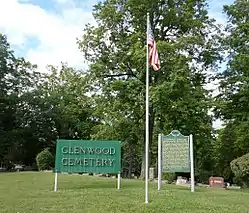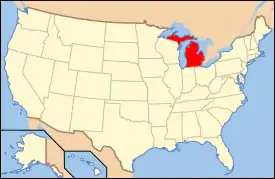Glenwood Cemetery (Flint, Michigan)
Glenwood Cemetery is a cemetery located at 2500 W Court Street in Flint, Michigan. It was listed on the National Register of Historic Places in 2010.[1]
Glenwood Cemetery | |
 | |
| Location | 2500 W Court St, Flint, Michigan |
|---|---|
| Coordinates | 43°0′25″N 83°43′17″W |
| Area | 37.2 acres (15.1 ha) |
| Built | 1857 |
| Architect | George T. Clark; et al. |
| Architectural style | Classical Revival, Late Victorian |
| NRHP reference No. | 10000616[1] |
| Added to NRHP | September 2, 2010 |
History
Flint was incorporated as a city in 1855. At the time, the area cemetery was beginning to decay, so in 1857 a group of leading citizens met to plan the construction of a cemetery suitable for the new city. The group formed the Glenwood Cemetery Association. Thirty acres of land was quickly acquired, and George T. Clark hired as a civil engineer. The new Glenwood Cemetery formally dedicated in October 1857. A gateway, chapel, and receiving vault (all now long-demolished) and the sexton's office (still standing) were built soon after, and the grounds graded and landscaped, including broad, winding roads and footpaths.[2]
The cemetery added six acres of land in 1901, and constructed a new mausoleum in 1914. No further additions to the cemetery grounds were made, and the Glenwood Cemetery Association continues to own and operate Glenwood Cemetery.[2]
Significant burials at Glenwood include:[2]
- Jacob Smith, the first European settler of Flint (1780-1825).
- Henry H. Crapo, Michigan governor (1804-69).
- Josiah W. Begole, Michigan governor (1815-96).
- J. Dallas Dort, carriage maker and early auto pioneer (1861-1925).
- Charles Stewart Mott, director of General Motors (1875-1973).
- Harlow H. Curtice, CEO of General Motors (1893-1962).
Description
Glenwood Cemetery is located on high, rolling ground overlooking the Flint River. The grounds are heavily wooded, and laid out with curving pathways through the grounds. A tall black wrought iron fence fronts the cemetery, and contains a main entrance with double-leaf iron gates between square random ashlar masonry gate posts of whitish random ashlar masonry that support double-leaf iron gates. Just inside the gate is the original sexton's office, a one-and-a-half-story gable-front building with a shed-roof addition. A second, similar entrance is located down the street. The later addition to the cemetery, located at the far eastern side, contains a Neoclassical mausoleum of gray granite.[2]
The grounds contain gravestones and monuments dating from the founding of the cemetery through the present. Early monuments include a substantial number of white marble markers, many of them obelisks, dating from the late 1850s to the 1870s. A few early sandstone and limestone monuments are also in the cemetery. The majority of monuments are granite, coming in a range of hues, dating from the 1880s and later. [2]
References
- "National Register Information System". National Register of Historic Places. National Park Service. November 2, 2013.
- Robert O. Christensen (April 2010), National Register of Historic Places Registration Form: Glenwood Cemetery
External links
- Glenwood Cemetery home page
- Glenwood Cemetery from Find-A-Grave

